Wooli, Diggers Camp and Minnie Waters on the lower Clarence Coast are ideally located for exploring the spectacular northern section of the Solitary Islands Marine Park.
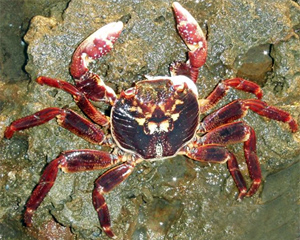 Encompassed by both the Marine Park and Yuraygir National Park, the coastal villages of Wooli and Minnie Water are popular destinations for eco-tourism.
Encompassed by both the Marine Park and Yuraygir National Park, the coastal villages of Wooli and Minnie Water are popular destinations for eco-tourism.
Anyone who loves being surrounded by nature, birds, wildlife and marine life and clean, protected waterways will find plenty of ways to enjoy their days here.
You don’t even need a boat to explore a good number of the Solitary Islands Marine Park’s attractions – see our suggestions below.
Sanctuary zones
The Solitary Islands Marine Park was first dedicated as a marine reserve in 1991 and changed to a marine park in 1998. During that time, protective sanctuary zones encompassed less than 1% of the park.
Armed with more information about the different habitats and species that exist in the park, authorities later rezoned the park in consultation with the community for further protection. Sanctuary zones currently make up 12% of the Solitary Islands Marine Park, with these zones representing the different habitats that exist within the park: estuaries, beaches, rocky shores and different types of reefs. Threatened species as well as many other marine species are also offered protection by the range of conservation measures.
Estuaries are very important nursery area for lots of species. Sea grasses and the like are great structures for fish to hide and feed. Estuaries are also very popular for fishing and crabbing, but you should be aware that while you’re allowed to crab trap and fish in yellow habitat protection areas, crab trapping is not permitted int he crab trapping closure in the Wooli Wooli River, which encompasses the southern arm and part of the main arm (upstream).
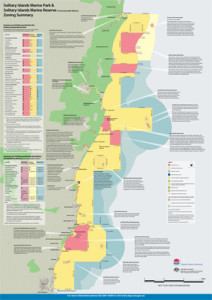 Zoning map
Zoning map
While you will find zoning maps and signs at various entrance points to the Marine Park, it’s good to plan ahead.
Why not familiarise yourself with the different zones and activities permitted and prohibited in each zone before you undertake any activities? You can do that right here.
Click on the small map on the right to open up a PDF map that you can zoom into for information about the various protection zones.
Offshore fishing
Recreational and commercial fishing, including line fishing, trapping, spearfishing, netting and trawling, are not allowed in sanctuary zones.
If you plan to go fishing off the Clarence Coast, you need the zoning map to ensure you steer clear of the pink sanctuary zones and are aware of the limitations in the other zones.
Snorkelling at Minnie Water
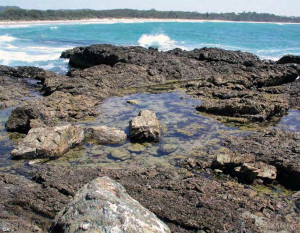 The shores at Minnie Water are great for snorkelling. Particularly at Minnie Water Lagoon, you will find ocean sea grass which is a great nursery area for fish. Because this is also a boat launching area, you should take care while snorkelling in certain sections of the lagoon.
The shores at Minnie Water are great for snorkelling. Particularly at Minnie Water Lagoon, you will find ocean sea grass which is a great nursery area for fish. Because this is also a boat launching area, you should take care while snorkelling in certain sections of the lagoon.
Minnie Water Back Beach is a protected sanctuary zone (pink on the zoning map), which means you are not supposed to fish or collect there.
Diggers rock platform
Diggers Camp is popular with campers and those who love its natural beach environment.
The rock platform at Diggers Camp is very flat and known for its molluscs diversity. You will find a number of very unusual species here.
While you can fish at Diggers Camp, the platform itself is a habitat protection zone with an additional collection closure so you are not allowed to collect from there.
Fishing and exploring the Wooli Wooli River
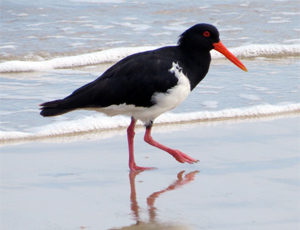 The Wooli Wooli River is popular with anglers and, except in sanctuary zones, you can fish there to your heart’s content.
The Wooli Wooli River is popular with anglers and, except in sanctuary zones, you can fish there to your heart’s content.
However, no spearfishing is allowed in the entire river and personal water craft such as jet skis are only allowed to transit from the lowest boat ramp to the open ocean at slow speed.
The dark blue area on the map is designated for oyster farming. Make sure you stay well away from the oyster farms.
If you make it all the way to the upper reaches of the river, there is a sanctuary zone in the Northern Arm. This protects a range of fish, crustaceans and plants in that area.
Uncommon birds you may encounter along the Wooli Wooli river shores include the brolga and jabiru (black-legged stork).
The crystal clear waters of the Wooli Wooli River, which is so clean because it is surrounded by national park and no development, are also fabulous for swimming, snorkelling, kayaking and canoeing.
Remote rock pools south of Wooli
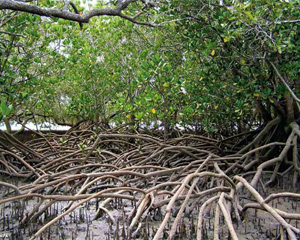 The area just south of Wooli is inaccessible and therefore untouched and really quite special. While difficult to land there, the remote beach (known as Jones Beach) can be reached by boat, or you can cross the river and walk until you reach it. There are lovely rock pools in this area that are fantastic for snorkelling.
The area just south of Wooli is inaccessible and therefore untouched and really quite special. While difficult to land there, the remote beach (known as Jones Beach) can be reached by boat, or you can cross the river and walk until you reach it. There are lovely rock pools in this area that are fantastic for snorkelling.
If you’re looking for a quiet place to get away from it all and don’t mind going to some trouble to get there, this isolated beach could be just what you’re looking for.
Diving the Solitary Islands Marine Park
There is so much to write about scuba diving in the Solitary Islands Marine Park that we have published a separate page about that.
Go to: Scuba diving the North Solitary Islands
Find out more
For more information about the Solitary Islands Marine Park, phone the NSW Marine Parks Authority’s Coffs Harbour office on (02) 6691 0600 or visit http://www.mpa.nsw.gov.au/simp.html